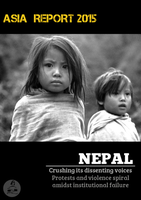
This year, 2015, did not start off well for Nepal. On April 25, a devastating earthquake hit the nation killing more than 9000 people, injuring thousands and destroying millions of dollars worth of property. Help poured in from all over the world to assist the poor Himalayan nation. Youths and volunteers were reaching out to victims and assisting them with whatever they had.
People in the villages however, were left to fend for themselves. It took 12 days for Congress and the political parties to come up with an official response. The lack of coordination between the government and the international community that flooded into Nepal to help was visible.
 At the onset of this devastation, Nepalese resilience was again proved. Neighbors helped neighbors, villages helped villages. However, something big was missing: the government. The government of Nepal was clearly unprepared for a disaster on this scale. It knew it was coming, but negligence led to being unprepared.
At the onset of this devastation, Nepalese resilience was again proved. Neighbors helped neighbors, villages helped villages. However, something big was missing: the government. The government of Nepal was clearly unprepared for a disaster on this scale. It knew it was coming, but negligence led to being unprepared.
With the winter fast approaching, victims of this natural disaster were on their own. With only a tent and dry food distributed by donors, they waited for government assistance. The government was busy however, planning what to do. Nothing ever reached the people other than glib words and fake promises.
Those who had links and networking with the government received help and compensation. The real victims, who did not enjoy such links, still await the government to fulfill its futile promises.
In the political realm, the government used this opportunity to complete writing the constitution. The three top Brahmins from the top three political parties saw it as an opportunity to fulfill their hidden desires of a Brahminical constitution. They mistakenly thought the average Nepali was too distracted by the earthquake; they did not realize the populace would hit the streets for their say in the new constitution.
In spite of the ongoing protests all over the country, the three Brahmins promulgated their constitution on 20 September 2015.
They neglected killings by the Nepal Police and the Armed Police Forces. Protesters were shot on sight and killed by angry policemen with direct orders from Kathmandu. Protesters were killed en masse with bodies dumped in many places. In a violent response, 10 police officers were mob-lynched, their bodies chopped up and burnt in the Kailali district. The protesters also burnt down many police posts and government offices.
Although it is the duty of the state to protect government offices, the level of force used to protect property such as police posts is disproportionate. It is a point of friction that the government uses water canons to control protests in Kathmandu, whereas in the Tarai they fire live bullets at the head and chest of protestors. This discrepancy has caused much anger.
Now, protests and desire for revenge spiraled into Nepal’s Southern Plains. Killings and revenge became the norm. Without mercy, protesters were shot to death, while injured police officers were dragged from ambulances and killed. 2015 saw the height of insanity in Nepal.
For the last four months, Madhes has been burning. A value for life has turned into a bullet. All over Madhes, there were demands for amending the constitution, and starting the process of demarcation and delineation.
To make the situation worse, India, a friendly neighbor in the past, ceded to the Madhesis demand of blocking the border. This meant stopping essential supplies including petrol, gas bullets, medicines and other necessary supplies from reaching Nepal. India never officially owned the blockade. But it was there under the clout of security for the Indian vehicles entering Nepal. It was a clear infringement of the sovereignty of Nepal. India stayed mute, citing security reasons.
The blockade affected the people of Nepal whether they were from Kathmandu or Madhes. Madhesis faced the brunt of the blockade and protests, with schools, offices, and markets completely shut down. Life had come to a standstill.
With all this upheaval in Nepal in 2015, something became clear. There are no readily available, reliable institutions to deal with a humanitarian crisis or human rights violations, by protesters or police. The government clearly looked inept as it tried to maintain peace and order in society, and protect the human rights of people.
The Sushil Koirala to the KP Oli led government have shown indifference towards what has been happening in the country. They lacked common sense and empathy for the peoples’ distress. Protests, blockades and revenge remain, with the government unable to address it.
Political dialogue must begin for the people to gain inclusive ownership of the new constitution. Lip service and verbal commitments from the government have not served to narrow the growing distrust in society. The following could pave the way towards wider ownership and reduce further violence in Nepal’s Terai: a written commitment, leading to the early amendment of the constitution, reflecting past agreements on electoral constituency, delineation based on population, on equal citizenship rights, on proportional inclusion, and the revision of provincial boundaries.
More lives will be sacrificed if the government keeps marching ahead with the view “Let the protesters shower with bullets”.
All this has happened because Nepal was not prepared and lacked viable institutions. Natural disasters and human rights violations committed before and after the constitution’s promulgation have destroyed Nepal. Let this not be the end. This critical time can be an opportunity for the government to reach out to the people. Now is a special time for Nepal as a people, to rebuild the nation and radically redesign and fundamentally transform already available institutions. Topmost priority must be given to the justice institutions.